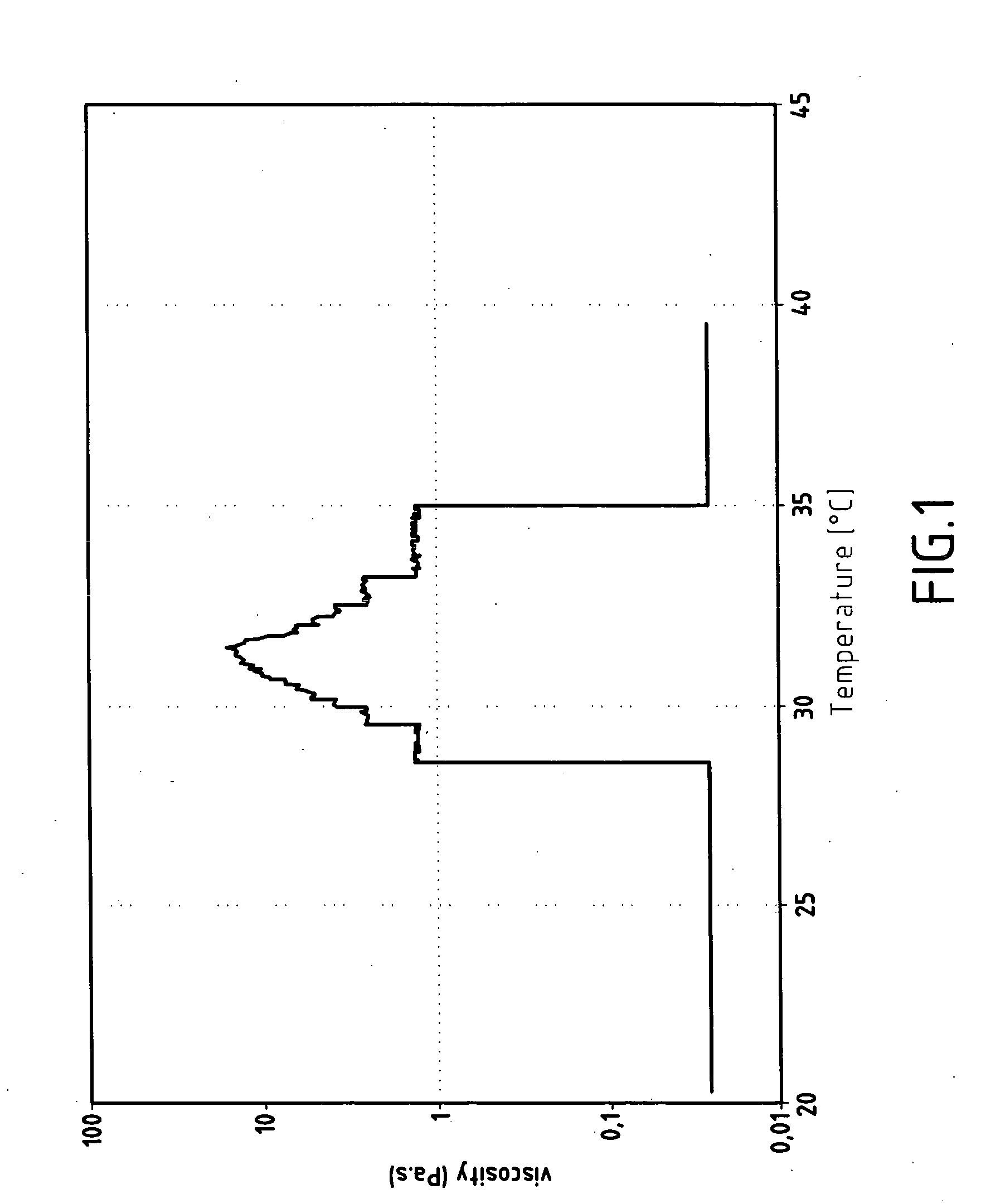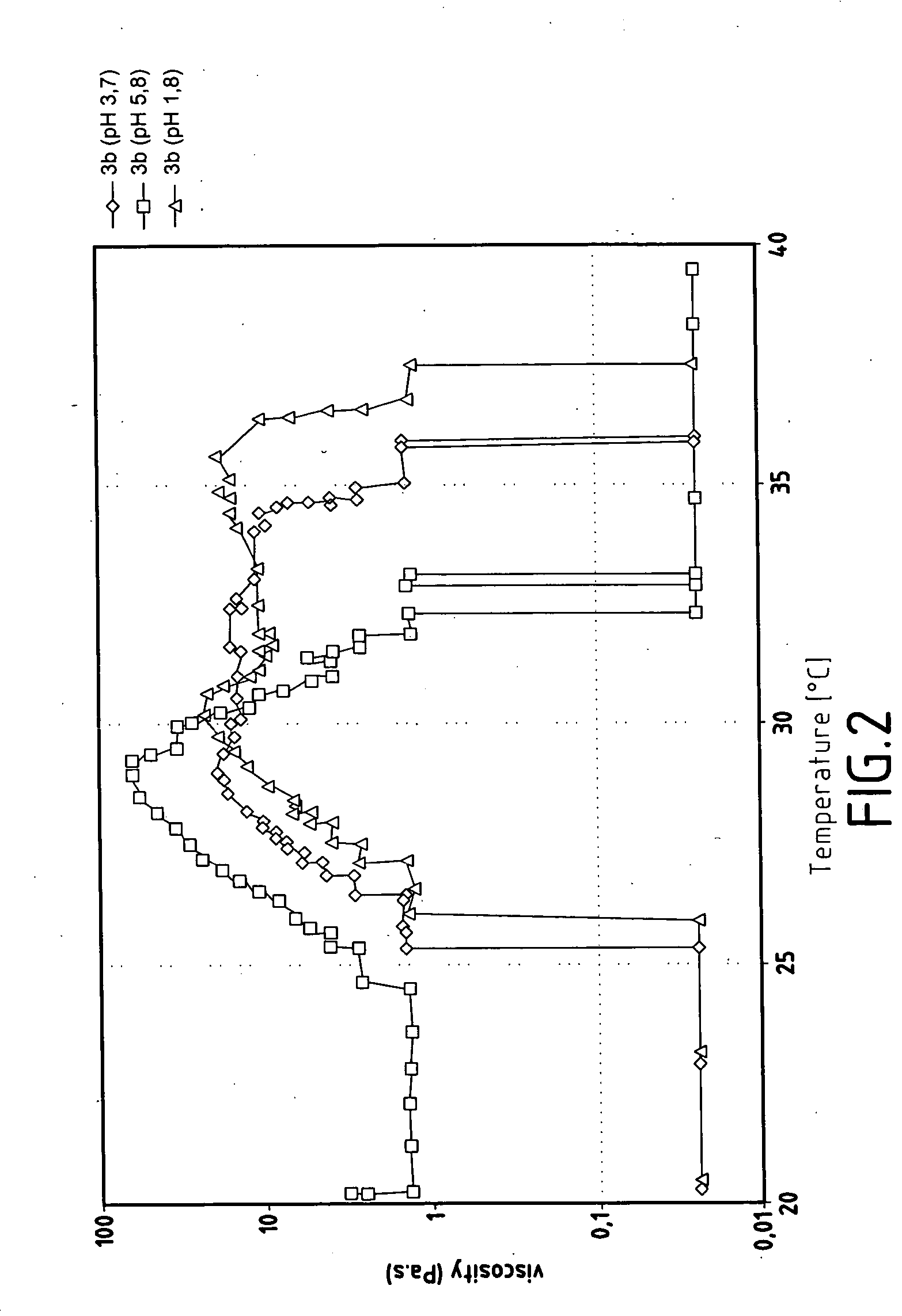Thermosensitive polymers and thermoreversible gels obtained from these polymers
a thermoreversible gel and polymer technology, applied in the field of thermoreversible gels, can solve the problems of compositions with reduced stability, compositions with limited bioadhesivity, and variations in viscosity that cannot reach a decade, and achieve the effect of improving the gel formation properties
- Summary
- Abstract
- Description
- Claims
- Application Information
AI Technical Summary
Benefits of technology
Problems solved by technology
Method used
Image
Examples
example 1
[0108] In this Example, 3.8·10−3 mole of a polymer bearing the reference F127 marketed under the name of Pluronic is dissolved in 150 ml of 2-butanone, the whole being brought to 70° C. The polymer F127 is introduced without purification and contains 0.3% by mass of water (7.6·10-3 mole). 11.4·10−3 mole of 4,4′-methylene biscyclohexyl di-isocyanate corresponding to the general formula:
are then added dropwise to the mixture over 10 minutes under a continuous flow of nitrogen. A tin-based catalyst is introduced (at the rate of 500 ppm) into the mixture, which is maintained under reflux of the solvent over about 20 hours.
[0109] After the mixture has attained ambient temperature, of the order of 20° C., a determined amount of water is added to the reaction mixture so that the content of thermosensitive polymer thus synthesised correspond to 5% of the total weight. The 2-butanone contained in the mixture is removed in vacuo. The solution containing 5% by mass of improved thermogellin...
example 2
[0111] This second Example of synthesis of improved thermosensitive polymer corresponds to the first type of polymer described above.
[0112] Only the stoichiometry of the reaction is more or less modified, the implementation being identical to the first Example. In this Example, 8.0·10−3 mole of 4,4′-methylene biscyclohexyl di-isocyanate are introduced into the mixture.
[0113] The solution of this improved polymer is characterised by its transparency and by an increase by 5 decades of the viscosity, under a shearing speed of 0.01 s−1, when its temperature attains 35° C.
example 3
[0114] This example of synthesis of improved thermosensitive polymer corresponds to the second type of polymer described above.
[0115] The improved thermosensitive polymer comprises polyacid blocks and tertiary amino blocks.
[0116] The synthesis is carried out in two steps. In a first step, 3.8·10−3 mole of non-dried F127 Pluronic polymer containing 0.3% by mass of water are dissolved with 7.7·10−3 mole of N-methyldiethanolamine in 150 ml of 2-butanone. 2.3·10−2 mole of 4,4′-methylene biscyclohexyl di-isocyanate are then added dropwise over 10 minutes under a continuous flow of nitrogen. 1.2·10−2 mole of tartaric acid in solution in 2-butanone are then added after six hours' reaction at 70° C. The polycondensation is continued for 2 hours until the complete disappearance of the isocyanate functions. The polymer is collected either directly in the aqueous phase, or after transfer of solvent or even by precipitation in ether or hexane.
[0117]FIG. 2 illustrates the variations in viscos...
PUM
| Property | Measurement | Unit |
|---|---|---|
| Temperature | aaaaa | aaaaa |
| Fraction | aaaaa | aaaaa |
| Fraction | aaaaa | aaaaa |
Abstract
Description
Claims
Application Information
 Login to View More
Login to View More - R&D
- Intellectual Property
- Life Sciences
- Materials
- Tech Scout
- Unparalleled Data Quality
- Higher Quality Content
- 60% Fewer Hallucinations
Browse by: Latest US Patents, China's latest patents, Technical Efficacy Thesaurus, Application Domain, Technology Topic, Popular Technical Reports.
© 2025 PatSnap. All rights reserved.Legal|Privacy policy|Modern Slavery Act Transparency Statement|Sitemap|About US| Contact US: help@patsnap.com



